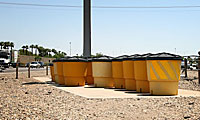Sand barrel crash cushions designed to take an impact
Sand barrel crash cushions designed to take an impact

Sand barrel crash cushions along I-10 in Phoenix near the Deck Park Tunnel
What’s filled with sand, weighs up to 1,400 pounds and is designed to save lives?
If you answered a sand barrel crash cushion, you’re correct!
And, if you didn’t have a guess then you’re probably asking: What’s a sand barrel crash cushion?
Let us explain…
Like their name implies, sand barrel crash cushions are filled with sand, shaped like a barrel and work to provide a “cushion” if a vehicle were to crash into one.
A sand barrel crash cushion works similarly to the way an attenuator functions (regular readers of this blog already know all about fixed attenuators and truck-mounted attenuators).
You’ve probably seen them several times on the side of the road. They’re placed strategically in front of fixed objects (signs, poles, etc.) and will take the impact if a driver runs into them. For a brief explanation of how this happens, let’s take a look at this excerpt from our blog post on fixed attenuators:
This is by no means a physics blog, but a basic grasp of how energy works is needed to understand attenuators …
A vehicle’s speed and size determine how much energy it has. Normally, this energy is dissipated by your brakes, which burn off that energy slowly, allowing you to come to a safe stop.
But, if a vehicle stops by crashing into a wall, the energy is dispersed very suddenly, resulting in a car that’s crushed. Attenuators won't exactly give a soft landing, but they do work to dissipate the energy slowly like your brakes do.
A little more on sand barrel crash cushions…
They can be set up in different configurations depending on speed limits and the specifics of the location.
One common setup consists of 12 barrels (although, there are numerous variations). You’ll often see four of the barrels lined up single file. Behind those first four, there typically will be four more rows with barrels lined up two by two.
The weight of each barrel varies – they weigh 200, 400, 700 or 1,400 lbs. The lightest barrels are placed in front and they get progressively heavier to handle the impact, absorb and dissipate the energy of a crash.
One more cool fact about these barrels: they come with inserts, which help crews fill them with sand accurately. Depending on the desired weight (they’re very light to begin with – before the sand goes in), they’ll use an insert designed to take up some of the space within the barrel. Crews then just have to fill with sand to the appropriate level to make sure it’s heavy enough.
And, just to give you an idea of how frequently they’re used – there’s about 4,000 barrels in the Phoenix district alone, which at 12 barrels a setup, translates to about 333 locations!

